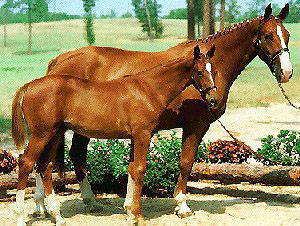

Hanoverian


Introduction: If you have any comments or suggestions, please click here.
Names: Hanoverian, sometimes called the Hannover. One source gave the German name as "Hannoveraner." Named after the state in Germany where it originated.
Origin: German
breed descended from war horses ridden in Middle Ages. Hanoverians have
been bred in northern Germany since English kings of the House of Hanover sent
over Thoroughbreds
to enhance some of the breed. They
also imported Hanoverians into their own Royal Stalls as carriage horses.
Some of the Hanoverians' origins are said to lie with two ancient German pony
breeds, but there are few, if any, Senner ponies running semi-wild in the
Tentoberger Wald nowadays. Hanoverian lineage compares with that of the Dülmen, mentioned in a document of 1316.
Breeding area and studs--Germany. Lower Saxony,
especially round Stade, Altes Land, Land Hadeln and Kehdigen; District Stud:
Celle. Numerous breeding areas for the Hanoverian included Pomerania,
Brandenburg, Mecklenburg and Westphalia. Following the unification of
German warm-blood breeding, the Hanoverian today (1960s) represents the lighter
of the two Standard Types. All horses registered with the Hannoversche
Verband (Hanoverian Society) are classed as Hanoverians and carry the
Hanoverian brand.
Breeding of the Hanoverian, originally founded by Holstein
and Mecklenburg sires, obtained its greatest
impetus from the systematic and consistent use of good stallions, particularly Thoroughbreds.
During the reigns of the English kings, the Central Stud at Celle was founded in
1735. The most important strains today are those of the stallions Adeptus,
Christian de Wet, Nelasko, Julius, Norfolk, Kingdom
and Flick. Extensive admixture of Thoroughbred
and East
Prussian stallions in recent times for
producing medium, good-looking saddle horses.
Breeding: After
World War II, with studs dispersed
and breeders dispossessed, a nucleus of registered, and fortunately branded
stock was collected. The first priority was to provide animals to replace
the almost non-existent tractors and farm horses.
Since 1948, the policy has been to produce quality riding
horses, good enough to compete internationally in "eventing" and on the show
ground. Mostly Trakehner
stallions, with a few Arabians
and Thoroughbreds,
have been used with registered mares -- whose pedigrees state the percentage of
alien blood. The stallions are State owned and kept at Celle where, each
autumn, they are shown in an attractive public exhibition. At three years
old the stallions are rigorously tested before receiving breeding certificates,
and they are then sent, in springtime, to farms all over the country.
A well-known German breed evolved largely from English
Thoroughbred stock. The inclusion, however, of "native" blood has resulted
in a heavier type of horse of about the same height as the Thoroughbred,
although the Hanoverian of today may be somewhat larger than at the turn of the
century (1900). The Hanoverian is popular in Germany as a hunger and
jumper.
Description: Beautiful lines; resembles the East Prussian in many respects, only the head being, generally speaking, less refined and the quarters more oblique. Apart form this it is generally stronger in the joints and more massive.
Action: Long, striding walk; energetic progressive trot; ground-covering, springy gallop; excellent jumping capacity.
Body: Large frame, beautifully set on long neck. Well-muscled back. Solid loins. Long, heavy, oblique shoulders; considerable depth in the girth; good barrel. Strong hindquarters. Tail beautifully set on and carried.
Color: Any solid color; often bay or brown. Chiefly bay in varying shades, but also chestnut, grey and black. Bay, brown, chestnut, or black; sometimes grey or white; often with white markings on the head and feet.
Legs: Powerful with clean tendons and joints; massive hocks.
Size: 16-17 hands. 16.1 to 17.1 hands.
Temperament: Of good-natured character and tranquil--generally even more docile than the East Prussian.
Features: Strong, noble saddle horse, also suitable for light draught work. In recent years, as a result of admixture of Thoroughbred and East Prussian blood, it has come much closer to being a pure saddle type and today provides many riding and jumping horses. Can be used in every branch of equestrianism. Noble, docile, very fast, with lots of expression.
Uses: Prior to World War II Hanoverians were dual-purpose animals, used extensively for farming and in demand as army mounts. Good show jumper.
Accomplishments:
Curiosities:
Profiles:
Conclusion: